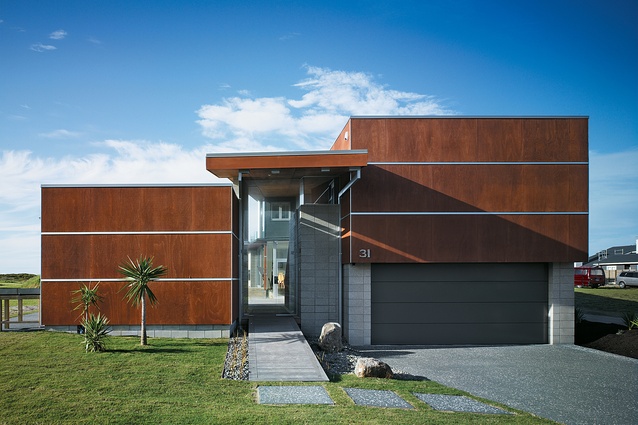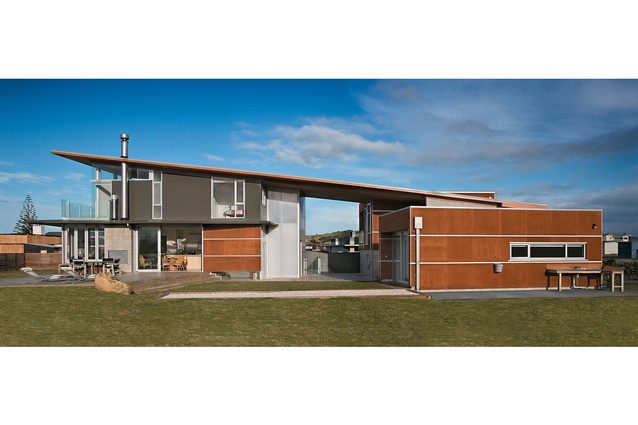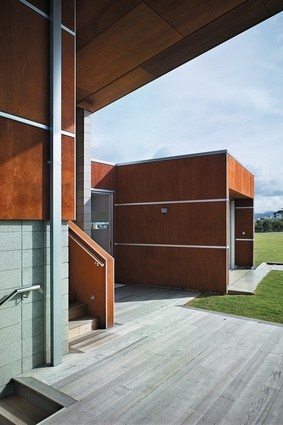Houses Revisited: Together apart
ALIGNwork’s trans-generational beach house, first published in 2008, is a welcome sight at a very mixed development.
The drive across the causeway to Omaha Beach, and into the latest development in the upmarket coastal precinct an hour north of Auckland, provides a sharp reminder of just how much beach resorts in New Zealand have changed. Gone are the haphazard sections and idiosyncratic baches of old; in their place stand suburban subdivisions that would look equally at home on the outskirts of a city.
The new development at Omaha South has used up the last chunk of approved building land that the 4km Mangatawhiri Spit has to offer and construction is in full swing. The resulting architectural mix includes everything from quasi-English country to “never mind the quality, feel the width”. It’s a relief, then, to turn a corner and see the beach house designed for an extended family by the Auckland architectural firm, ALIGNworks.
Husband and wife team Jennie and Rob Aerts set up ALIGNworks in 2004 after returning from four years’ OE in San Francisco. They lured Jennie’s architect father, Allan Lowe, out of semi-retirement and set about establishing a boutique firm that would offer “a personal approach” to architecture and design. At South Omaha, their brief was to design a weekend haven, one site back from the beach, which would provide living and sleeping spaces for different generations.
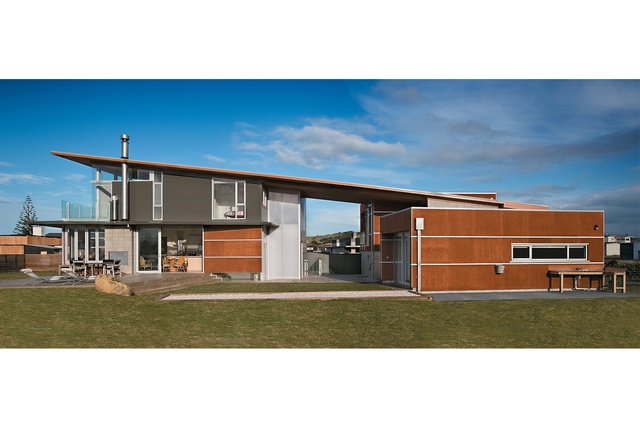
The clients comprise an Auckland couple, plus their son and his wife and baby; privacy and separation were thus paramount concerns. The other consideration was the need to maximise sea views (of the outer Hauraki Gulf) in a development where new houses jostle for space. A local planning covenant dictates that view corridors must be left open and building heights are restricted to 6m on the sea front and 7.5m further back.
The Aertses designed an angular form, with two wings positioned on either side of an enclosed courtyard and linked by a large raking roof. The house is entered via a timber ramp that leads through a heavy glass front door, along a boardwalk and into the courtyard. The Aertses sought to provide a “transitional” threshold so that once the family entered the courtyard they would immediately feel they were on holiday.
On the ground floor of the smaller wing is the younger generation’s living room – the “Games Room” – complete with a powerful sound system. Exterior stairs provide access to two bedrooms and a bathroom. The rooms are not large, but the windows are generous. Lights embedded in the outside deck provide a soft glow, guiding the way between the two wings of the house. Translucent Danpalon polycarbonate sheeting has been used to wrap a tower housing the main interior stairwell and shower, creating a focal “lantern” at night.

Across the courtyard, double doors lead into the senior generation’s open-plan kitchen-dining-living area. The architects chose white high-gloss cabinetry and oak veneer for the kitchen, along with an Italian stone-composite bench. A multi-coloured glass splash-back, selected by the owners, provides a touch of contrast, but overall the subdued palette prevents the kitchen from dominating the living space.
The multi-purpose room is modestly sized (53m²); the clients opted for a large patio and lawn rather than the “huge” indoor living spaces of some of their neighbours. “[The clients] were keen that the living area should be intimate and family-scaled,” explains Rob Aerts. “But we have tried to make it flow seamlessly onto the concrete patio [via stacking sliders] so that you still get a strong sense of space.”
In modern beach houses, comfort is paramount. Both living areas in this weekend retreat have gas fires that can be switched on for instant heat, and under-floor heating provides additional warmth. Above the main fireplace a flat-screen TV is fixed to the wall. Despite the modern accoutrements, the Aertses say they wanted to achieve “a relaxed, beachy environment”. Throughout the house the architects have employed bach-appropriate materials such as stained Shadowclad lightweight plywood and corrugated coloured steel cladding, marine plywood soffits and greenheart decking. Marine plywood is also used on the underside of the large roof.
Upstairs, the master bedroom and balcony have a view corridor to Little Barrier Island. A neighbouring house, being built across the width of a waterfront section, also dominates the view but Rob Aerts says that once trees and other greenery have become established, most houses will disappear into the landscape. “People pay so much for land” at Omaha, Aerts says, that “it’s hardly surprising that they try to fit as much living space onto it as possible.”
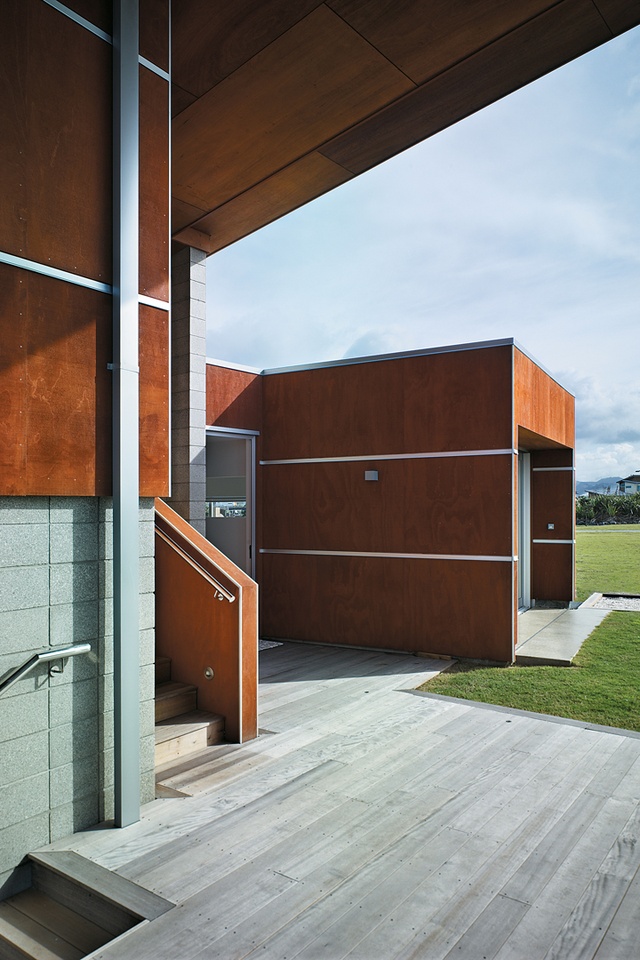
With colour selection, simplicity was the order of the day: Resene Quarter Thorndon Cream paint has been used throughout the house, complemented by blues and sandy browns. In the main bedroom a large wardrobe is hidden behind translucent sliding glass doors. All walls, ceilings and floors have been insulated; the house is extremely quiet. Cabinetry in the bathrooms and laundry area has been crafted from marine plywood, and in the main ensuite porcelain tiles that look remarkably like real bamboo add to the “natural feel” the architects were seeking.
On the upstairs landing, a small built-in unit contains a fridge, wine glasses and crockery. On top, a tap which produces instant boiling water is positioned over a multi-coloured glass basin – an artwork bought by the owners. Could this be the modern-day version of a Teasmade – the apogee of modern appliances in 1970 when Omaha Beach was first developed as a resort?
Despite being so close to the beach, the house has a spa pool – an amenity that is increasingly de rigueur at the modern bach. But the Aertses were also instructed to include a more traditional amenity: an outside sink and bench for cleaning the catch after a day’s fishing. Nearby, a small wood-framed pétanque “court” has been built alongside the lawn.
If this house – and others like it – have more mod cons than seem strictly necessary for a weekend retreat, the Aertses point out that some bach owners eventually move north permanently; several hundred “Omaharians” already live at the beach all year round. The architects have spent a weekend at the house as guests of the owners and report that they were pleased with the way it works. “It was a cold, rainy weekend,” says Jennie Aerts, “but the house still had a very good feel to it. We didn’t want to change a thing.”
Click here to see more Houses Revisited. And sign up to our email newsletters to receive Houses Revisited straight to your inbox.

